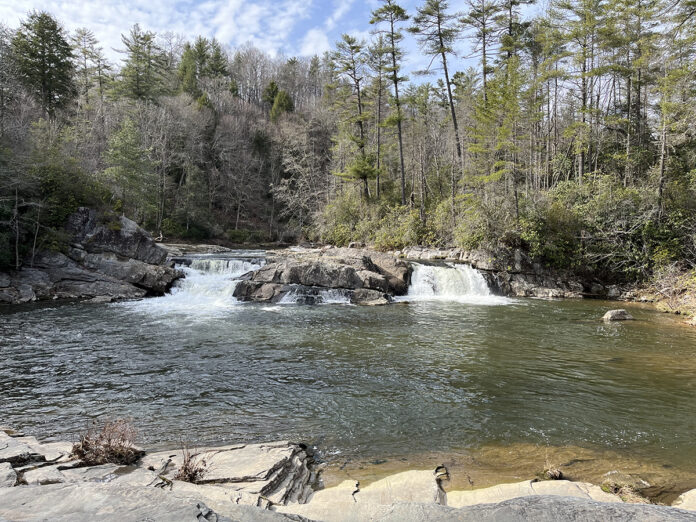
After climbing Mount Mitchell along the Blue Ridge Parkway in North Carolina, my daughter and I continued our trip north. We chose to stay on the parkway, instead of taking a faster route on a freeway. Each turn was a magnificent view of the surrounding mountains, expansive and impressive.
In my imagination, we had traded in our trusty Chevy Equinox for a 1966 Ford Galaxie 500. It was a red convertible and we had the wind blowing in our hair as we rounded every bend. We were on a great American road trip with only an atlas and our spontaneity guiding us.
Linville Falls

My reverie was interrupted and I was brought back to reality when my daughter spotted a sign for Linville Falls. Located at mile 316, the series of waterfalls is a favorite subject of professional and amateur photographers.
The Linville River begins high on the rugged slope of Grandfather Mountain. The water makes a quick ascent into the gorge by plunging over Linville Falls. Towering hemlock trees line the gorge which is sometimes referred to as “The Grand Canyon of North Carolina.” Quartzite outcroppings form unique cliffs along the riverbanks.
Our hike to four different vistas took us through many dense thickets of rhododendron. I mused again about how beautiful it must be to explore the Blue Ridge trails during the blooming season in late April into June.
As we approached the first set of lower falls, we noticed the flat, smooth rocks that comprise the stream bed. The first viewing area seemed very peaceful, like an area that would be fun for swimming.
That idea quickly vanished when we turned to our right and walked a little further. The river abruptly dropped in a zig-zag, plunging over more boulders and outcroppings of rocks. The water rapidly changed in momentum and mood from placid to violent. We immediately understood the need for “No Swimming” signs along the river.
We hiked about just under a mile out, stopping at four different viewpoints and looking at the upper falls. With increasing elevation, each vista showed us more of the river and gorge located far below.
I could understand why the Cherokee called the Linville River, Eeseeoh, the “River of Cliffs.” The Cherokee extensively hunted in the area. In 1766, William and John Linville were killed by Native Americans while hunting near the falls which were later named after them.

Linn Cove Viaduct
When we hit the road again, I explained my fictional scenario of the 60s convertible. I got the “My mom is so weird,” side-eye look from my daughter before she asked me to pass the snacks. She seemed more interested in trail mix than time travel. It was probably better for us anyways, because our next destination was not in existence in the 1960s.
The Linn Cove Viaduct located at mile 304 was the missing link of the parkway for decades. Viaducts are raised sections of roadway used to carry the road across the shoulders of mountains or over dry ravines. The challenge of creating the Linn Cove Viaduct was to not disturb the ecological area or detract from the natural beauty of the surroundings.
While construction of the Blue Ridge Parkway began in 1935, funding for the building of the Linn Cove viaduct did not get approval by Congress until 1979. The viaduct is significant for two reasons.
It was built with environmental protection as a main goal and it is considered an engineering masterpiece. At the price of almost $10 million, the construction was finished in 1983 and a ribbon-cutting ceremony was held in 1987 after additional road work was completed.
The sun was high in the sky and only a little wind was stirring the treetops as we cruised across the viaduct. A total of 153 segments, weighing 50 tons each, are connected to form 1,243 feet of gentle curves, essentially hugging Grandfather Mountain. The concrete was even tinted with iron oxide to match existing outcroppings under the viaduct. Nothing man-made detracts from the views of the natural landscape and mountain ridges.
Rough Ridge
We squeezed in one more hike to see the Linn Cove viaduct from an elevated position. Rough Ridge is a section of the Tanawha Trail known for its great views of Grandfather Mountain and the viaduct. Located at mile 302.8, the trail is strenuous as it quickly gains over 800 feet in elevation.
Choosing to only hike a short portion, we were pleased with the spectacular views from various outcroppings of rock. If the movie “The Lion King” was filmed along the Blue Ridge Parkway, this is where Mufasa would’ve lifted his son Simba high above his kingdom.
The Linn Cove viaduct was the symbolic end to our trip to the “high country” of North Carolina. After a wonderful one-night stay in Blowing Rock, North Carolina, we headed north toward Ohio.
The brightly colored blooms faded away as we crossed West Virginia. Until spring flowers make their vibrant appearance in northeast Ohio, memories and pictures of the Blue Ridge Parkway will have to hold us over.












